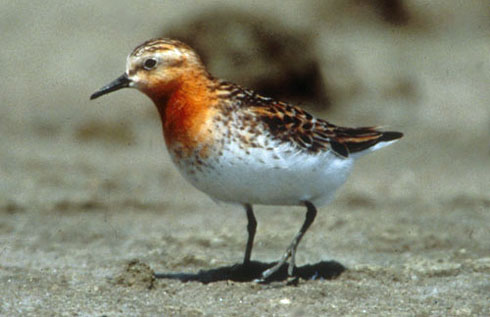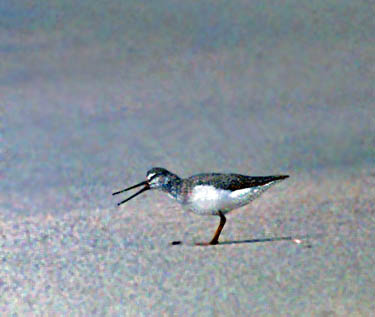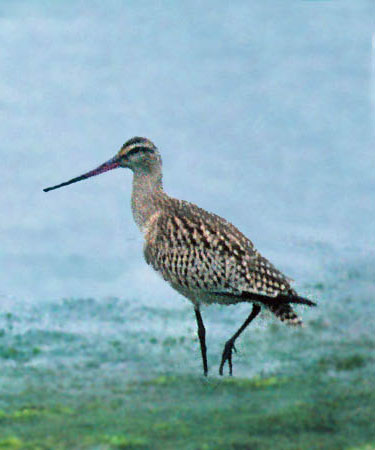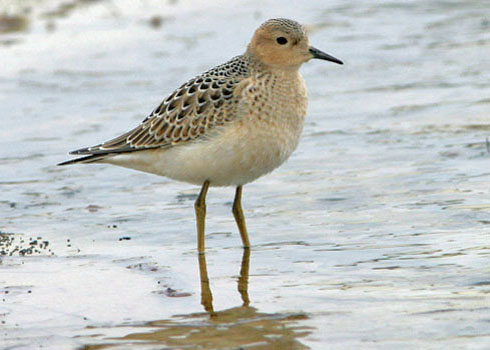| |
 |
SANDPIPERS Scolopacidae |
- 91 species worldwide
- DR personal total: 71 species (78%), 63 photo'd
|
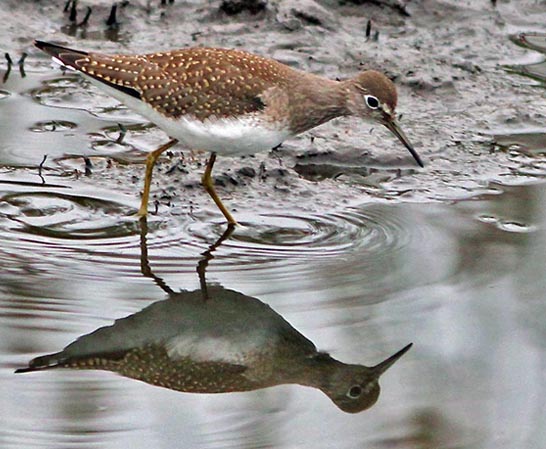 Sandpipers are found in wetlands and along shores around the globe. Many species nest from the Arctic tundra to temperate climes in the Northern Hemisphere, and most of these migrate south after breeding. They range from the small Red-necked Phalarope that migrates in large flocks over the open ocean (above, a flock with Humpback Whale); to the dainty mid-sized Solitary Sandpiper (left), which breeds in wet boreal forests, using abandoned songbird nests, and then winters in the Caribbean and Neotropics; to the long-legged Upland Sandpiper (below, in an evocative shot by Ed Harper), whose whistled cry carries over fragment of long-grass prairie during summer in central North America, and then they fly to the pampas of southern South America for the winter. These are examples of the diversity within the Scolopacidae, but the family includes ground-dwelling snipes and resident woodcocks in cloud forests of tropical islands. Sandpipers are found in wetlands and along shores around the globe. Many species nest from the Arctic tundra to temperate climes in the Northern Hemisphere, and most of these migrate south after breeding. They range from the small Red-necked Phalarope that migrates in large flocks over the open ocean (above, a flock with Humpback Whale); to the dainty mid-sized Solitary Sandpiper (left), which breeds in wet boreal forests, using abandoned songbird nests, and then winters in the Caribbean and Neotropics; to the long-legged Upland Sandpiper (below, in an evocative shot by Ed Harper), whose whistled cry carries over fragment of long-grass prairie during summer in central North America, and then they fly to the pampas of southern South America for the winter. These are examples of the diversity within the Scolopacidae, but the family includes ground-dwelling snipes and resident woodcocks in cloud forests of tropical islands.
All seem to have arisen from a single ancestor that underwent an explosive evolution in the early Tertiary period (Piersma 1996). The beautiful patterns on juvenal-plumaged birds are among the most striking in the world, while the colorful and complex breeding plumages camouflage adults on their nests in the arctic tundra. Many arctic breeders spend the non-breeding months south of the Equator, brightening the lives of birders in the austral summer (our boreal winter).
|
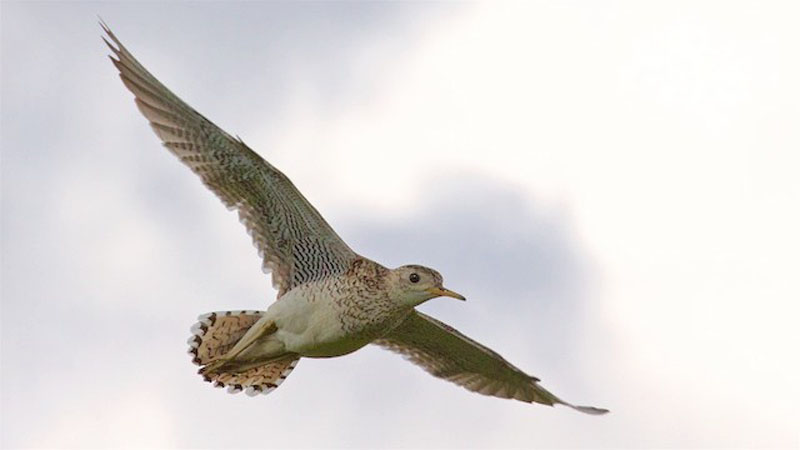 |
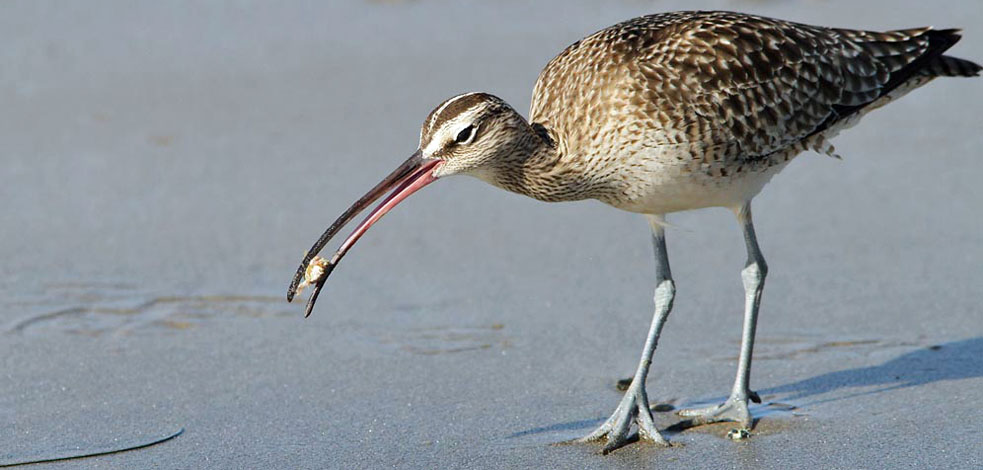 |
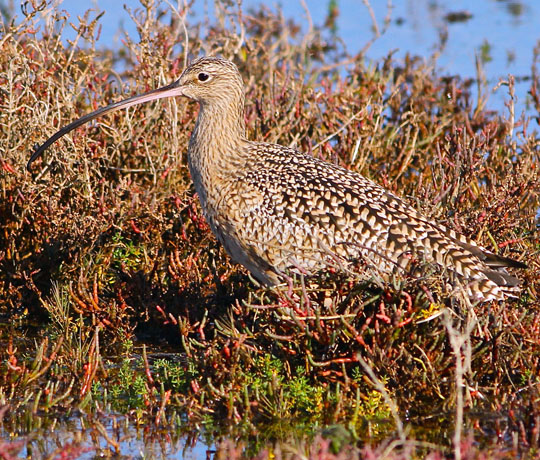 Under current taxonomy, there are 15 genera holding the 91 extant species of sandpipers. Three are monotypic genera with just one species — for example, Upland Sandpiper is the only member of Bartramia — but 3 of the 4 sandpipers in genus Prosobonia are extinct. The only remaining Prosobonia is the endangered Tuamotu Sandpiper P. parvirostris, a resident endemic to that isolated Pacific archipelago. There are 3 island-endemic snipe in genus Coenocorypha, and two more are extinct in New Zealand. This leaves ten genera — each with 2 to 24 species — to discuss. Bird observers often consider sandpipers in family Scolopacidae as among of larger set of "waders" that include plovers [family Charadriidae], or even gulls and terns [family Laridae]. These are all in Order Charadriiformes. I think of the term "waders" as the migrant Charadriiformes — essentially the migrant plovers and sandpipers. Under current taxonomy, there are 15 genera holding the 91 extant species of sandpipers. Three are monotypic genera with just one species — for example, Upland Sandpiper is the only member of Bartramia — but 3 of the 4 sandpipers in genus Prosobonia are extinct. The only remaining Prosobonia is the endangered Tuamotu Sandpiper P. parvirostris, a resident endemic to that isolated Pacific archipelago. There are 3 island-endemic snipe in genus Coenocorypha, and two more are extinct in New Zealand. This leaves ten genera — each with 2 to 24 species — to discuss. Bird observers often consider sandpipers in family Scolopacidae as among of larger set of "waders" that include plovers [family Charadriidae], or even gulls and terns [family Laridae]. These are all in Order Charadriiformes. I think of the term "waders" as the migrant Charadriiformes — essentially the migrant plovers and sandpipers.
The largest shorebirds are 7 species of Numenius curlews [the smallest, Eskimo Curlew N. borealis, is extinct] and 4 species of Limosa godwits. The most widespread curlew is Whimbrel (above, shown snatching prey at low tide), with migrant populations in both the New World and Old World (a possible split someday?). Long-billed Curlew (right) is the largest wader in North America, and among curlews, only Far Eastern Curlew N. madagascariensis is larger. Far Eastern breeds in northeast Asia and migrates to Australasia. Long-billed Curlew breeds in the Great Plains; most move to the coasts of the United States and Mexico for winter.
All curlews have down-curved bills of varying lengths; the four Limosa godwits sport long, upturned bills. As curlew, godwits, and a plethora of other waders forage in the same tidal mudflats, the variety bills permit multiple species to exploit specific prey species without direct competition with each other. The two godwits in North America are Marbled Godwit (below left) and Hudsonian Godwit (below right). Like Long-billed Curlew, Marbled Godwit breeds on northern prairies and winters on the ocean shores of the U.S. and Mexico. Hudsonian Godwit breeds on subarctic shores at James and Hudson Bays, and then undertakes a long flight of thousands of miles, some of it non-stop, to winter in the southern cone of South America. This particular Hudsonian Godwit (below right) is a juvenile well out of range in coastal central California. |
|
 |
The most speciose genus is Calidris — a set of 24 migrants that range from small to mid-sized sandpipers. These are perhaps the most familiar of all shorebirds, but which species are common and which are rare vagrants depends on where you are. In central California, where I live, a familiar scene of spring migrant Calidris at Moss Landing is shown above: 7 Dunlin (with black belly patch) and 8 Western Sandpiper, each in breeding (or "alternate") plumage. These plumage are often very colorful both above and below. To learn identification in migrant shorebirds, observers must learn three plumages: breeding (=alternate), a juvenal plumage in fall migrant for birds born that summer, and a winter (=basic) plumage. |
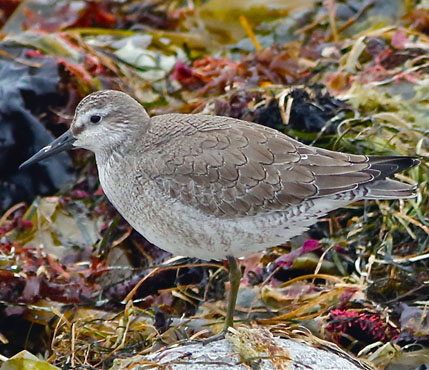 |
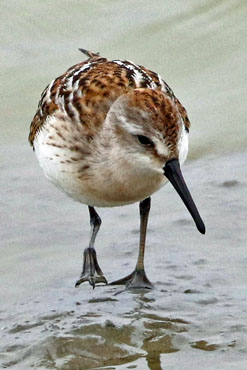 |
Waders in juvenal plumage ("juveniles") show characteristic patterns on the upperwing coverts, scapulars, and/or tertials. A juv. Red Knot (far left) has soft gray upperparts with each feather having a shaft streak and a well-defined black subterminal border at its tip, forming an "anchor" pattern for each feather. A juv. Western Sandpiper (near left) has "zones" of brightly-edged back and scapular feathers: some red-edged, some white-edged, and also has webbed toes (most other Calidris have unwebbed toes). |
| Upon reaching the wintering grounds, both adults and juveniles molt into a winter plumage ("basic" or "formative," depending on age but the patterns are very similar). The winter plumages have evolved to provide protection when feeding in the open on muddy tidal flats or pond edges — a plain gray or gray-brown above, and essentially all-white below (some with streaked breasts and others white-breasted). Examples here are Temminck's Stint (near right), an Asian migrant wintering in southeast Asia, and a Least Sandpiper in flight (far right). Least Sandpiper is an abundant wintering small Calidris throughout the New World, both coastal and in the interior, from the southern United States through northern South America. |
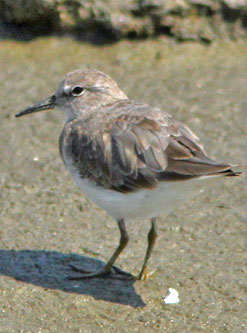 |
 |
|
| The wide variety of migrants, and the close relationships of many, present numerous identification challenges. Learning the three plumages of each Calidris sandpiper is the most important step in understand how to identify the waders. The identification literature is impressive. These are the two classic papers which pushed the frontiers of shorebird i.d. well beyond prior information: Jonsson & Grant (1984) and Veit & Jonsson (1987). Both use the paintings of Lars Jonsson to illustrate all three plumages (juvenal, basic, and alternate), and these papers were instrumental in getting observers to understand that the first step in wader i.d. is to ask: "what age is it?" Peter Grant's text is written from a British perspective (e.g., Little Stint Calidris minuta is the common small stint) while Veit's text is written from an American perspective (e.g., Least Sandpiper is the common small "peep;" Little Stint is a very rare vagrant). These papers were the foundation for all further books and articles, and still worth reading some 35 years later. Prater et al. (1977), Hayman et al. (1987), Chandler (1989), and Paulson (1993) were all important books as identification expertise developed, and led to more recent literature such as O'Brien et al. (2006) or the wader accounts in Howell et al. (2014). |
In the New World, high-arctic breeding Calidris that make a spectacularly long migration to South America include Pectoral Sandpiper (below, upper) and Baird's Sandpiper (below, lower). Pectoral is unusual both for its polygynous or promiscuous mating system, and for the male's inflatable throat sac, with which it gives hollow hoots in display flights. Baird's Sandpiper has an exceptionally long and rapid migration, with many completing the entire 15,000 km [9300 mi] journey in as few as 5 weeks.
In the Old World, the widespread mid-sized Ruff (upper right, this one a juvenile) displays in leks, with females visiting a site in which multiple males display colorful plumes. From east Asia, Sharp-tailed Sandpiper (middle right, a juvenile) flies from Siberia to Australia, but vagrants sometimes appear among Pectoral flocks in western North America. The famed Spoon-billed Sandpiper (lower right) has a totally unique bill, but is also critically endangered, with perhaps just 200 remaining. Updates on conservation efforts on both its Russian breeding grounds and south Asia winter sites is in Zockler et al. (2020). This adult Spoon-billed Sandpiper was photographed on Attu I., Alaska, by Ed Greaves in May 1986. |
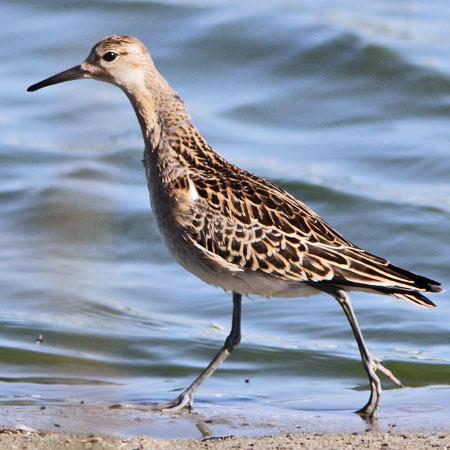 |
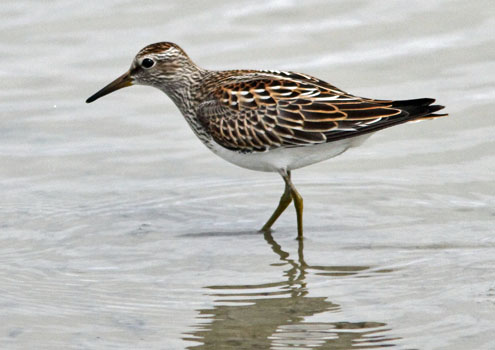 |
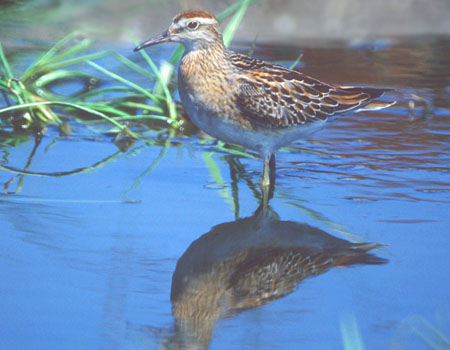 |
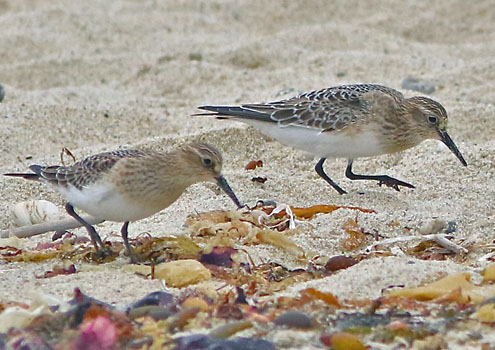 |
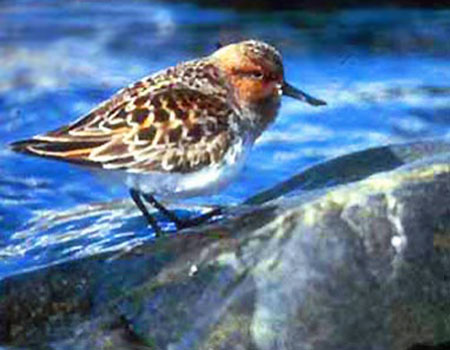 |
|
 |
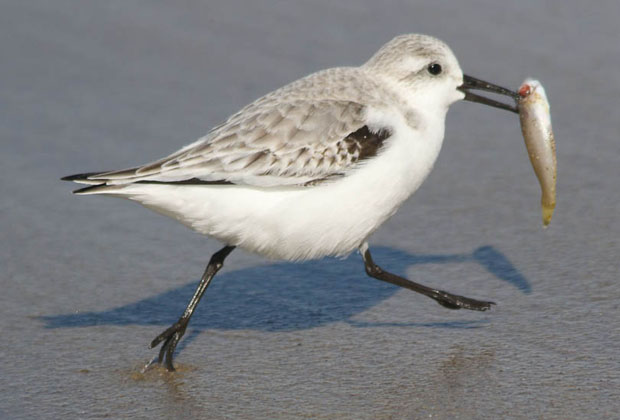 A worldwide Calidris is Sanderling (above & left). While breeding is limited to the tundra in the extreme north across the Holarctic, Sanderlings disperse southwards across the globe to all continents except Antarctica. Breeders typically nest in pairs, but if a female lays two clutches, one will be brooded by the female and the other by the male. Its non-breeding biology has been extensively studied; e.g., Myers et al. 1979, Myers 1983, Myers 1984, and others. A worldwide Calidris is Sanderling (above & left). While breeding is limited to the tundra in the extreme north across the Holarctic, Sanderlings disperse southwards across the globe to all continents except Antarctica. Breeders typically nest in pairs, but if a female lays two clutches, one will be brooded by the female and the other by the male. Its non-breeding biology has been extensively studied; e.g., Myers et al. 1979, Myers 1983, Myers 1984, and others.
For example, large numbers are common on California sandy beaches in winter. High-tide roosts (above; in this September photo, the birds with black-centered upperparts are juveniles) can involve hundreds of birds. At low tide, Sanderlings are seen chasing back-and-forth as the waves crest and ebb, but this behavior is not cooperative. Rather, many individual Sanderlings defend small territories along the beach, but my switch to non-territorial behavior in the presence of an abundance of food. [I enjoy the title of a paper by J.P. Myers (1983): "Sanderlings have no friends."]
Sanderling eat whatever they can find and swallow, even scavenged dead fish (left). More typically they eat all sorts of insects, pelagic worms, tiny crustaceans, crab eggs, washed-up jellyfish ... well, you name it. |
 Shorebirds of the rocky shore endure the constant tides and pounding surf. Surfbird (right & below left) is the classic rocky shore species. These two (right) were moments late in flying away from the breaking wave, and got soaked. They, and the one below (left) were just coming into breeding (alternate) plumage. This plumage provides camouflage up on the rocky barren montane breeding grounds in Alaska. "The Surfbird's winter range is among the longest and narrowest of any North American breeding bird. During the boreal winter, Surfbirds are found from Kodiak Island, Alaska, to the Strait of Magellan, Chile, a distance of over 17,500 km [just over 10,000 miles], and the winter range extends inland only a few meters above the tide line. Outside the breeding season, this species is confined almost entirely to rocky coastal shores, where it feeds on mollusks and other intertidal prey, often amid the splash and spray of incoming waves; hence its name" (Senner & MaCaffery 2020). Surfbird was formerly in genus Aphriza, but genetic research showed it was related to Red Knot, and it is now assigned to Calidris (Gibson & Baker 2012). Shorebirds of the rocky shore endure the constant tides and pounding surf. Surfbird (right & below left) is the classic rocky shore species. These two (right) were moments late in flying away from the breaking wave, and got soaked. They, and the one below (left) were just coming into breeding (alternate) plumage. This plumage provides camouflage up on the rocky barren montane breeding grounds in Alaska. "The Surfbird's winter range is among the longest and narrowest of any North American breeding bird. During the boreal winter, Surfbirds are found from Kodiak Island, Alaska, to the Strait of Magellan, Chile, a distance of over 17,500 km [just over 10,000 miles], and the winter range extends inland only a few meters above the tide line. Outside the breeding season, this species is confined almost entirely to rocky coastal shores, where it feeds on mollusks and other intertidal prey, often amid the splash and spray of incoming waves; hence its name" (Senner & MaCaffery 2020). Surfbird was formerly in genus Aphriza, but genetic research showed it was related to Red Knot, and it is now assigned to Calidris (Gibson & Baker 2012).
Here on the Monterey Peninsula, where I live, Surfbirds continue to be regular among wintering flocks of Black Turnstone. Wandering Tattler (below right, also shown in alternate plumage), is another obligate of the rocky shoreline. For many years both tattlers (Wandering in the New World, Gray-tailed in the Old World) were assigned to genus Heteroscelus. Sibley & Ahlquist merged them into Tringa, and that has been confirmed by recent research (Gibson & Baker 2012). Wandering Tattler used to winter here regularly. Its population here has declined this century, and wintering individuals are now rare. Migrants, though continue to pass through during spring and fall migrations. |
|
|
| The two species of turnstones remain in their own genus (Arenaria), despite molecular research that merged other rocky shorebirds into Calidris or Tringa. Ruddy Turnstone (above left) is one of the most widespread sandpiper in the world. It breed in the Holarctic tundra, among the northernmost of all waders, and then migrates to winter in both tropical sandy shores and southern coasts. In contrast, Black Turnstone (above right) is entirely restricted to the west coast of North America, breeding in western Alaska and wintering on rocky shores south to west Mexico. Unlike Ruddy Turnstone, Black Turnstone is entirely restricted to rocky tidal coasts, except for the occasional stop on a sandy beach in migration (and not for long). Both turnstones are opportunistic feeders, turning over rocks, kelp, shells, and debris with its stout, slightly upturned upper mandible. In winter, Ruddy Turnstone digs in sand and beach jetsam; Black Turnstone is adept at prying loose chitins, mussels, and barnacles (Piersma 1996). In the photos (above) of both species, the birds are in breeding plumage, ready to migrate northwards, but still working rocky pools at low tide on the Monterey Peninsula. |
|
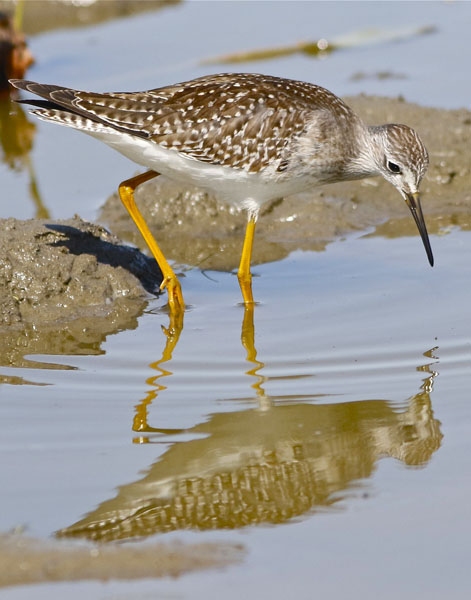 Sandpipers from four more genera are long-distance migrants. Red Phalarope (above left, breeding-plumaged female) and Red-necked Phalarope (flock with whale shown at top of this page) are Holarctic breeders that migrate widely across the world's oceans to winter in the Southern Hemisphere. In fact, Red Phalarope is entirely pelagic apart from the breeding grounds, coming ashore to coastal ponds only during storms or strong on-shore winds [Red Phalarope is called "Grey Phalarope" in the Old World.] Red-necked Phalarope also migrates inland as well as at sea. Wilson's Phalarope (above right; a flock of juveniles) breeds solely in west-central North America, in prairie pot-holes. Thereafter, nearly all adults undertake a molt migration and stage, often in huge flocks, at saline lakes in the Great Basin, before migrating to similar wintering habitats in the Altiplano of Bolivia and Argentina. All three phalaropes are known for their reversed sex-role mating systems. Larger and more brightly-plumaged females compete for mates and then the males provide all parental care. Sandpipers from four more genera are long-distance migrants. Red Phalarope (above left, breeding-plumaged female) and Red-necked Phalarope (flock with whale shown at top of this page) are Holarctic breeders that migrate widely across the world's oceans to winter in the Southern Hemisphere. In fact, Red Phalarope is entirely pelagic apart from the breeding grounds, coming ashore to coastal ponds only during storms or strong on-shore winds [Red Phalarope is called "Grey Phalarope" in the Old World.] Red-necked Phalarope also migrates inland as well as at sea. Wilson's Phalarope (above right; a flock of juveniles) breeds solely in west-central North America, in prairie pot-holes. Thereafter, nearly all adults undertake a molt migration and stage, often in huge flocks, at saline lakes in the Great Basin, before migrating to similar wintering habitats in the Altiplano of Bolivia and Argentina. All three phalaropes are known for their reversed sex-role mating systems. Larger and more brightly-plumaged females compete for mates and then the males provide all parental care.
With the addition of the two tattlers, genus Tringa now has 13 species. This group is sometimes called “shanks” (e.g., Baker et al. 2007), and some also include genus Actitis (see below) in the set. Most Tringa sandpipers have longish legs, a longish neck and delicate frame, and often straight bills of varying lengths. A mid-sized North American Tringa is Lesser Yellowlegs (left, in juvenal plumage). The species breeds in meadows and muskegs in the boreal forest of North America, then migrates, primarily through the center of the United States, to winter in the Neotropics. Other "shanks" include Spotted Redshank of northern Eurasia and wintering to tropical Africa and south Asia (top row below, left), and Willet of North America (top row below, right). The two isolated populations might refer to separate species. All Willets have the striking wing pattern.
The two species in genus Actitis — Spotted Sandpiper in the New World (lower row below, left), Common Sandpiper A. hypoleucos in the Old — have characteristic teetering behavior and fly with distinctive shallow, stiff wing beats. Spotted Sandpiper's breeding behavior recalls that of the role-reversal in phalaropes; some Common Sandpipers may be polyandrous as well.
The three species of dowitcher in genus Limnodromus all breed well north in the Holarctic — Asian Dowitcher L. semipalmatus on the Siberian steppes, with Long-billed Dowitcher (lower row below, right) and Short-billed Dowitchers L. griseus in the Nearctic — but all in differing habitats. All migrate southwards; the large and uncommon Asian Dowitcher reaches south Asia, Java, and northeast Australia. All are quite reddish or orange in breeding plumage but are gray-and-white in winter; juvenal plumages are distinctive.
|
|
 The final groups of sandpipers are woodcocks (genus Scolopax) and snipes (genus Gallinago). Six of the 8 woodcocks are island endemics in montane cloud forests. The remaining two — Eurasian Woodcock S. rusticola and American Woodcock (right; a collage of two shots of the same bird) — are migratory. These migrants woodcocks nest in extensive woodlands with swamp pools or marshes, and eat primarily earthworms with their long bills in the soft soil. Their breeding system is polyandry, with females choosing mates after observing the males' roding flights. "Roding" is the male display flight, lasting several minutes, typically at dusk and dawn, with slow, deliberate wingbeats, with bill head downwards. Roding may include vocalizations as well. These spectacular "sky-flights" are given by the tropical island species also. The final groups of sandpipers are woodcocks (genus Scolopax) and snipes (genus Gallinago). Six of the 8 woodcocks are island endemics in montane cloud forests. The remaining two — Eurasian Woodcock S. rusticola and American Woodcock (right; a collage of two shots of the same bird) — are migratory. These migrants woodcocks nest in extensive woodlands with swamp pools or marshes, and eat primarily earthworms with their long bills in the soft soil. Their breeding system is polyandry, with females choosing mates after observing the males' roding flights. "Roding" is the male display flight, lasting several minutes, typically at dusk and dawn, with slow, deliberate wingbeats, with bill head downwards. Roding may include vocalizations as well. These spectacular "sky-flights" are given by the tropical island species also.
American Woodcock breeds widely in northeast North America, and then the populations move to the southeastern U.S. for winter. These comparatively short-distance migrations have spun vagrants westward, even as far as California. The photos (right) are of California's first record in Nov 1998.
The six endemic woodcocks on east Pacific islands from Japan to New Guinea are all mysterious and rarely seen species. The one that is resident in some cloud forests in the Philippines is Bukidnon Woodcock Scolopax bukidnonensis; it was not described to science until 2001 (Kennedy et al. 2001). I was able to see one in Dec 2005 from a camp at 1368m high on Mt. Katanglad, Mindanao, in muddy cloud forest where it rained heavily many days. I wrote: "Every dawn & dusk we've hearing Bukidnon Woodcock for brief periods at 5:10 a.m and 5:40 p.m., but the bird itself was roding low in a clearing adjacent to our camp and could not be seen. Today I walked up to that adjacent field at 5 a.m. At 5:07 a.m. the roding woodcock flew directly over my head and I got bins on it: a chunky woodcock shape, long straight woodcock bill, no tail visible. The sound is very unique — like a brief spectral jangling of keys."
|
|
There are 10 species of snipe in genus Gallinago. [Other snipes are Jack Snipe Lymnocryptes minimus of Eurasia, in its monotypic genera, and the 3 extant Coenocorypha snipes on sub-Antarctic islands.] The Gallinago snipes include a mix of residents, altitudinal migrants, and long-distance migrants. A few of the larger snipe are distinctive, but most of these snipe are similar in plumage to each other and are distinguished best by calls, behavior, or difficult to see plumage distinctions. Many are shy, crepuscular, and blend into their swampy habitats. Snipes probe soft soils for invertebrates and often not noticed until flushed. Wilson's Snipe (both photos above) is the widespread snipe in North America. It breeds across Canada and the northern tier of U.S. states, and winters from the southern United States to northern South America. In winter or on migration, most views are of a flushed snipe flying rapidly away, giving a sharp, raspy scaip call. On the breeding grounds, though, males will perch up atop fence posts in their territory (above right), and at dusk and dawn perform spectacular flight displays, while producing a haunting, tremulous "winnowing" sound with out-spread outer rectrices.
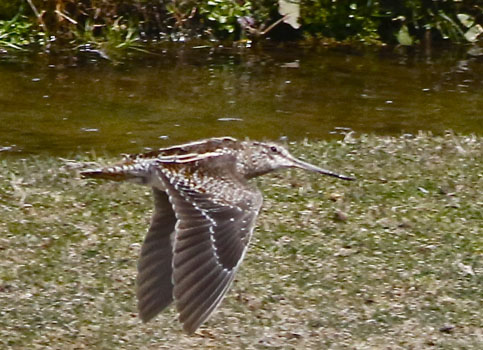 The Solitary Snipe (left) is a largish snipe of the Himalayas and other mountain ranges in eastern Asia. It is almost exclusively found at high altitudes [1500–5000 m = 5000–16,000 ft elevation], well above treeline, in river valleys, grassy swamps and mountain bogs. This one was foraging alone along a stream at 3200m [10,500' elev] in Bhutan. The population moves downslope when high-elevation waters freeze, but rather little to known about this species. The Solitary Snipe (left) is a largish snipe of the Himalayas and other mountain ranges in eastern Asia. It is almost exclusively found at high altitudes [1500–5000 m = 5000–16,000 ft elevation], well above treeline, in river valleys, grassy swamps and mountain bogs. This one was foraging alone along a stream at 3200m [10,500' elev] in Bhutan. The population moves downslope when high-elevation waters freeze, but rather little to known about this species.
Another little-known species is Giant Snipe (photos below). It is the world's largest snipe and exists in patchy locations, up to 2200m [7000' elev] in South America, from Colombia and Venezuela to southeast Brazil (but not in Amazonian lowlands). I did get to see display flights near Itatiaia NP in Brazil — the second photo is a collage of two shots of displays overhead at dusk — and you can see the out-spread outer rectrices with which are part of the display, as are rhythmic vocalizations. There were at least 3 in the wet pasture we visited at dusk. |
|
| |
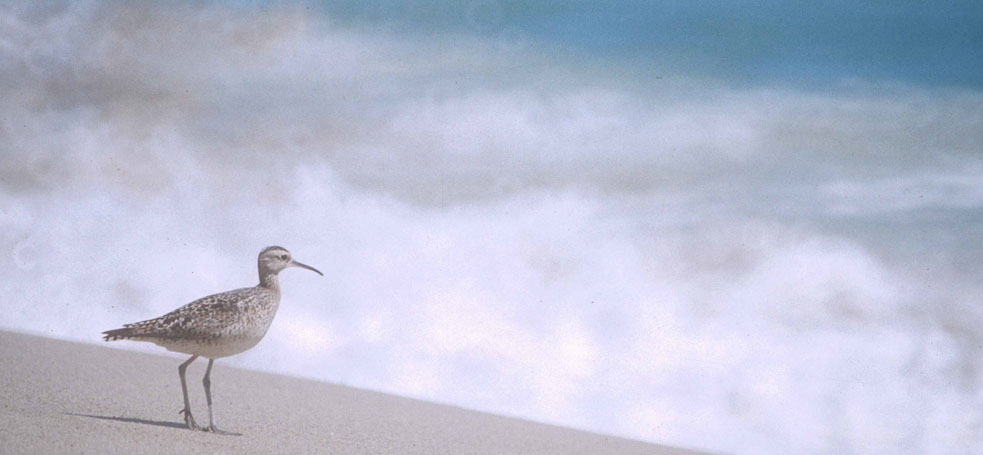 |
While to crepuscular and elusive snipes and woodcocks are fascinating, it is the migrant waders that are favorites of keen birders and bird-listers. Such migrants, with their lengthy migrations that produces strong seasonality in local occurrences — not to mention the challenges in sorting out the various species and their three distinctive plumages — while always keeping in mind the possibility of a rare vagrant, creates this esteem. It used to be a joke among American birders traveling overseas in the last century that if they run into another birder, one can tell their nationality by their interests. If the observer was keen on raptors, he or she is apt to be Scandinavian. If the observer is searching out little brown jobs in the forest undergrowth, that's likely to be an American. But if the observer has eyes only for the waders — that's likely a Brit. Of course this is an exaggeration, yet it did hold a grain of truth . . . I'm not sure in the new generations of birders fall into such regional categories, but the migrations and plumages of the Scolopacidae are, indeed, compelling stuff.
Sometimes as I walk along a beach and watch skittering sandpipers chasing the waves, I think about just how far each bird has traveled to reach the spot that it and I now share. I suppose this is a bit too metaphysical for some folks but it was, for example, essentially the premise of Last of the Curlews, the personalized and fictional story of the last Eskimo Curlew on earth (Bodsworth 1954). In this light, I rather like the photo above. It shows an adult Little Curlew — the closest relative to Eskimo Curlew left on earth — standing on a beach, possibly contemplating its next long flight over the crashing surf and endless Pacific Ocean to its final destination. Little Curlew has one of the longest migration routes — from northeast Siberia to Australasia — and although it is not on the edge of extinction, its numbers are rather small (~200,000; Piersma 1996). This photo documents one of the very few Little Curlews to reach North America, a vagrant bird that appeared in California during the autumns of 1984, 1988, 1993 (in Santa Barbara County) and finally in fall 1994 on Carmel State Beach in my own Monterey County, where this photo was taken. |
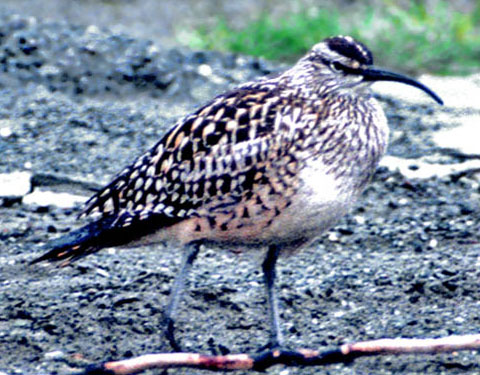 On another beach, at another time (May 1998), Rita and I had driven hours northward to document another curlew: California's first Bristle-thighed Curlew in Del Norte County (right). It, too, has an amazing story and life history. Although the species was known from oceanic islands, its nesting grounds in western Alaska were not discovered until 1948! (Allen 1948, Allen & Kyllingstad 1949). A recent summary of its biology and behavior reads: "Bristle-thighed Curlew is one of the most unusual of all shorebirds. It is the only migratory shorebird that winters exclusively on oceanic islands and the only shorebird known to become flightless during molt and to use tools when foraging. Like only a handful of other species, it takes on huge fat stores to fuel long nonstop flights over open ocean and reduces the size of its nutritional organs in preparation for these flights. All Bristle-thighed Curlews fly at least 4,000 km (2500 mi) nonstop between Alaska and the northern end of the winter range in the northwestern Hawaiian Islands. Studies of marked birds on Laysan Island revealed that curlews wintering in the Central and South Pacific overfly the Northwestern chain during spring and fall migration, making nonstop flights in excess of 6,000 km (3700 mi) twice each year. Thus, along with Bar-tailed Godwits (Limosa lapponica), Bristle-thighed Curlews make one of the longest nonstop flights known for any bird" (Marks et al. 2020). On another beach, at another time (May 1998), Rita and I had driven hours northward to document another curlew: California's first Bristle-thighed Curlew in Del Norte County (right). It, too, has an amazing story and life history. Although the species was known from oceanic islands, its nesting grounds in western Alaska were not discovered until 1948! (Allen 1948, Allen & Kyllingstad 1949). A recent summary of its biology and behavior reads: "Bristle-thighed Curlew is one of the most unusual of all shorebirds. It is the only migratory shorebird that winters exclusively on oceanic islands and the only shorebird known to become flightless during molt and to use tools when foraging. Like only a handful of other species, it takes on huge fat stores to fuel long nonstop flights over open ocean and reduces the size of its nutritional organs in preparation for these flights. All Bristle-thighed Curlews fly at least 4,000 km (2500 mi) nonstop between Alaska and the northern end of the winter range in the northwestern Hawaiian Islands. Studies of marked birds on Laysan Island revealed that curlews wintering in the Central and South Pacific overfly the Northwestern chain during spring and fall migration, making nonstop flights in excess of 6,000 km (3700 mi) twice each year. Thus, along with Bar-tailed Godwits (Limosa lapponica), Bristle-thighed Curlews make one of the longest nonstop flights known for any bird" (Marks et al. 2020).
A couple
Bristle-thighed Curlews reached California and adjacent states in May 1998 only through an unusual confluence of El Niño seas and weather conditions; full story, with photos, is in Patterson (1998).
|
|
| |
Photos: The flock of Red-necked Phalarope Phalaropus robatus, with Humpback Whale, was in Monterey Bay, California, on 16 July 2016. The juvenile Solitary Sandpiper Tringa solitaria was at Pacific Grove, Monterey Co., California, on 20 Aug 2015. Ed Harper photographed the in-flight Upland Sandpiper Bartramia longicauda in Meagher County, Montana, on 5 July 2019. The foraging Whimbrel Numenius phaeopus was at Del Monte beach, Monterey, California, on 3 Feb 2012. The Long-billed Curlew Numenius americanus was along Elkhorn Slough, Monterey Co., on 12 Dec 2015. The Marbled Godwit Limosa fedoa was at Del Monte beach, Monterey, on 20 Jan 2016. The vagrant juv. Hudsonian Godwit Limosa haemastica was at the Salinas River NWR, Monterey Co., on 7 Aug 2019. The mixed flock of breeding plumaged Dunlin Calidris alpina and Western Sandpiper Calidris mauri was at Moss Landing, Monterey Co., on 20 May 2018. The juv. Red Knot Calidris canutus was at Pebble Beach, Monterey Co., on 25 Aug 2019, and the juv. Western Sandpiper Calidris mauri showing its webs was near Salinas on 22 Aug 2021. The basic-plumaged Temminck's Stint Calidris temminckii was at Pak Thale, Thailand, on 22 Dec 2012. The in-flight Least Sandpiper Calidris minutilla was at Moss Landing, Monterey Co., on 15 Dec 2018.
The juv. Ruff Calidris pugnax was near Salinas, Monterey County, on 17 Sep 2014, and the juv. Pectoral Sandpiper Calidris melanotos was at the same site on 3 Sep 2015. The juv. Sharp-tailed Sandpiper Calidris acuminata was at Moonglow Dairy, Moss Landing, on 22 Sep 1986. The two foraging Baird's Sandpiper Numenius phaeopus were at Del Monte beach, Monterey, California, on 19 Aug 2007. Ed Greaves photographed the Spoon-billed Sandpiper Calidris pygmaea was on Attu I., western Aleutians, Alaska, on 31 May 1986. The flock of Sanderling Calidris alba was at Salinas River NWR, Monterey Co., on 3 Sep 1995, and the Sanderling with fish was at Del Monte beach, Monterey, 4 Feb 2015. The two wave-drenched Surfbird Calidris virgata were at the Big Sur R. mouth, Monterey Co., on 21 Mar 2009; the other shot of a Surfbird molting into breeding plumage was at Monterey in Mar 2006. The breeding-plumaged Wandering Tattler Tringa incana was at Pt. Pinos, Monterey Co., on 13 Aug 2018. The breeding-plumaged Ruddy Turnstone Arenaria interpres was at Pt. Pinos, Monterey Co., on 26 Apr 2013, and two adult Black Turnstone Arenaria melanocephala were at Pebble Beach, Monterey Co., on 26 July 2014. The breeding-plumaged Red Phalarope Phalaropus fulicarius was at Pt. Joe, Pebble Beach, on 9 May 2008. The flock of Wilson's Phalarope Phalaropus tricolor was near Salinas, Monterey Co., on 22 Aug 2021.
The juv. Lesser Yellowlegs Tringa flavipes was near Salinas, Monterey County, on 25 Aug 2019. The basic-plumaged Spotted Redshank Tringa erythropus was at Pak Thale, Thailand, on 22 Dec 2012. The in-flight Willet Tringa semipalmata was at Del Monte beach, Monterey, on 27 Jan 2017. The adult Spotted Sandpiper Actitis macularius was at Laguna Grande, Seaside, California, on 21 May 2021. The adult Long-billed Dowitcher Limnodromus scolopaceus was near Salinas, Monterey Co., on 19 Apr 2010. The two shots of a vagrant American Woodcock Scolopax minor were taken at Iron Mt. Pump Station, San Bernardino Co., California, on 9 Nov 1998. The photos of Wilson's Snipe Gallinago delicata were taken at, respectively, Asilomar SB, Monterey Co., on 13 Jan 2019, and in Diamond Valley, Alpine Co., California, on 20 June 1999. The Solitary Snipe Gallinago solitaria was in the Ura Valley, Bumthang, Bhutan, on 25 Mar 2019. The photos of Giant Snipe Gallinago undulata were taken near Itatiaia NP, Brazil, on 4 Aug 2020. The vagrant Little Curlew Numenius minutus was on Carmel SB, Monterey Co., on 9 Sep 1994. The rare Bristle-thighed Curlew Numenius tahitiensis was at Crescent City, Del Norte Co., California, on 16 May 1998. John Sorensen photographed the adult Red-necked Stint Calidris ruficollis at Moss Landing, Monterey Co., on 14 July 2001. The vagrant Terek Sandpiper Xenus cinerea was on Carmel SB, Monterey Co., on 6 Sep 1988. The juv. Bar-tailed Godwit Limosa lapponica was at Moonglow Dairy, Moss Landing, on 4 Sep 1994. The juv. Buff-breasted Sandpiper Calidris subruficollis was at Asilomar SB, Pacific Grove, on 28 Aug 2006. The juv. Little Stint Calidris canutus was at Moonglow Dairy, Moss Landing, on 19 Sep 1985.
All photos © Don Roberson, except for those attributed to W. Ed Harper, Ed Greaves, and John Sorensen, and used with permission; all rights reserved.
Family book: 
Hayman, Peter, John Marchant & Tony Prater. 1986. Shorebirds: An Identification Guide to the Waders of the World. Croom Helm, London.
[Note: this review is from 1999; there are now many more recent books that include the Scolopacidae] This book covers all the Charadriformes — not just sandpipers — and so includes plovers, stilts, avocets, jaçanas, thick-knees, and pratincoles. It is not a "family book" per se, since its focus is on identification problems, but it does include sections on "habits" and migratory or seasonal "movements." Breeding biology and similar topics are not covered here. However, the quality of the identification text more than makes up for this "defect", and adding broader topics would have made for a very fat book. The text — an upgrade from his 1977 guide (with Prater & Vuorinen) — surveys the then-existing literature well in addition to original research. The book does rely on Hayman's paintings for illustrations and while they are generally good, I think that photos are a necessary requirement when dealing with the subtleties of shorebird identification. So use this book as an introduction to these families — and the identification problems that exist — but rely on other texts for state-of-the-art details. A generalized introduction to this family, with more good photos, is in Piersma (1996).
Literature cited:
Allen, A.A. 1948. The curlew's secret. National Geographic Magazine 94: 751–770.
Allen, A.A., and H. Kyllingstad. 1949. The eggs and young of the Bristle-thighed Curlew. Auk 66: 343–350.
Baker, A.J., S.L. Pereira, and T.A. Paton. 2007. Phylogenetic relationships and divergence times of Charadriiformes genera: multigene evidence for the Cretaceous origin of at least 14 clades of shorebirds. Biology Letters 3: 205–209.
Bodsworth, F. 1954. Last of the Curlews. Longman's, London.
Chandler, R.J. 1989. North Atlantic Shorebirds: A Photographic Guide to the waders of western Europe and eastern North America. Facts on File, New York & Oxford.
Gibson, R., and A. Baker. 2012. Multiple gene sequences resolve phylogenetic relationships in the shorebird suborder Scolopaci (Aves: Charadriiformes). Molec. Phylog. Evol. 64: 66–72.
Hayman, P., J. Marchant, and T. Prater. 1986. Shorebirds: An Identification Guide to the Waders of the World. Croom Helm, London.
Howell, S.N.G., I. Lewington, and W. Russell. 2014. Rare Birds of North America. Princeton Univ. Press, Princeton, N.J., & Oxford.
Jehl, J.R. 1979. The autumn migration of Baird's Sandpiper. Studies in Avian Biology 2: 55–68.
Jonsson, L, and Grant, P. J. 1984. Identification of stints and peeps. Brit. Birds 77: 293–315.
Kennedy, R.S., T.H. Fisher, S.C.B Harrap, A.C. Diesmos, and A.S. Manamtam. 2001. A new species of woodcock (Aves: Scolopacidae) from the Philippines and a re-evaluation of other Asian/Papuasian woodcocks. Forktail 17: 1–12.
Marks, J.S., T.L. Tibbitts, R.E. Gill, and B.J. McCaffery. 2020. Bristle-thighed Curlew (Numenius tahitiensis), version 1.0. In Birds of the World (A. F. Poole & F. B. Gill, eds). Cornell Lab Ornith., Ithaca, NY. https://doi.org/10.2173/bow.brtcur.01
Myers, J.P. 1983. Space, time, and the pattern of individual associations in a group-living species: Sanderlings have no friends. Behavioral Ecology & Sociobiology 12: 129–134.
Myers, J.P. 1984. Spacing behavior of non-breeding shorebirds, pp. 271–321 in Shorebirds: Migration and Foraging Behavior (J. Burger & B.L. Olla, eds.). Plenum Press, New York.
Myers, J.P., P.G. Conners, and F.A. Pitelka.1979. Territoriality in non-breeding shorebirds. Studies in Avian Biology 2: 231–246.
O'Brien, M. R. Crossle, and K. Karlson. 2006. The Shorebird Guide. Houghton Mifflin, Boston.
Patterson, Mike. 1998. The great curlew fallout of 1998. Field Notes 52: 150–155.
Paulson, D. 1993. Shorebirds of the Pacific Northwest. Univ. of Washington Press, Seattle.
Piersma, T. 1996. Family Charadriidae (Sandpipers), pp. 444–543 in Handbook of the Birds of the World (del Hoyo, J., A. Elliott & J. Sargatal, eds). Vol. 8. Lynx Edicions, Barcelona, Spain.
Prater, A. J., J. H. Marchant, & J. Vuorinen. 1977. Guide to the Identification and Ageing of Holarctic Waders. BTO Guide 17. British Trust for Ornithology, Tring, England.
Senner, S.E. and B.J. McCaffery. 2020. Surfbird (Calidris virgata), version 1.0, in Birds of the World (A.F. Poole & F.B. Gill, eds). Cornell Lab Ornith., Ithaca, NY. https://doi.org/10.2173/bow.surfbi.01
Sibley, C.G., and J.E. Ahlquist. 1990. Phylogeny and Classification of Birds: a Study of Molecular Evolution. Yale Univ. Press, New Haven, CT.
Veit, R. R., and Jonsson, L. 1987. Field identification of smaller sandpipers within the genus Calidris. Amer. Birds 41: 212–-236.
Zockler, C., S.U. Chowdhury, L. Sun, C. Qing, P.P. Aung, J. Clements, K. Khlokov, E.G. Lappo, and E. Syroechkovskiy. 2020. The Spoon-billed Sandpiper Calidris pygmaea conservation project in 2019 and 2020: populations trends continue to be negative. Birding Asia 33: 51–57.
|
|
|






 A worldwide Calidris is Sanderling (above & left). While breeding is limited to the tundra in the extreme north across the Holarctic, Sanderlings disperse southwards across the globe to all continents except Antarctica. Breeders typically nest in pairs, but if a female lays two clutches, one will be brooded by the female and the other by the male. Its non-breeding biology has been extensively studied; e.g., Myers et al. 1979, Myers 1983, Myers 1984, and others.
A worldwide Calidris is Sanderling (above & left). While breeding is limited to the tundra in the extreme north across the Holarctic, Sanderlings disperse southwards across the globe to all continents except Antarctica. Breeders typically nest in pairs, but if a female lays two clutches, one will be brooded by the female and the other by the male. Its non-breeding biology has been extensively studied; e.g., Myers et al. 1979, Myers 1983, Myers 1984, and others.  Shorebirds of the rocky shore endure the constant tides and pounding surf. Surfbird (right & below left) is the classic rocky shore species. These two (right) were moments late in flying away from the breaking wave, and got soaked. They, and the one below (left) were just coming into breeding (alternate) plumage. This plumage provides camouflage up on the rocky barren montane breeding grounds in Alaska. "The Surfbird's winter range is among the longest and narrowest of any North American breeding bird. During the boreal winter, Surfbirds are found from Kodiak Island, Alaska, to the Strait of Magellan, Chile, a distance of over 17,500 km [just over 10,000 miles], and the winter range extends inland only a few meters above the tide line. Outside the breeding season, this species is confined almost entirely to rocky coastal shores, where it feeds on mollusks and other intertidal prey, often amid the splash and spray of incoming waves; hence its name" (Senner & MaCaffery 2020). Surfbird was formerly in genus Aphriza, but genetic research showed it was related to Red Knot, and it is now assigned to Calidris (Gibson & Baker 2012).
Shorebirds of the rocky shore endure the constant tides and pounding surf. Surfbird (right & below left) is the classic rocky shore species. These two (right) were moments late in flying away from the breaking wave, and got soaked. They, and the one below (left) were just coming into breeding (alternate) plumage. This plumage provides camouflage up on the rocky barren montane breeding grounds in Alaska. "The Surfbird's winter range is among the longest and narrowest of any North American breeding bird. During the boreal winter, Surfbirds are found from Kodiak Island, Alaska, to the Strait of Magellan, Chile, a distance of over 17,500 km [just over 10,000 miles], and the winter range extends inland only a few meters above the tide line. Outside the breeding season, this species is confined almost entirely to rocky coastal shores, where it feeds on mollusks and other intertidal prey, often amid the splash and spray of incoming waves; hence its name" (Senner & MaCaffery 2020). Surfbird was formerly in genus Aphriza, but genetic research showed it was related to Red Knot, and it is now assigned to Calidris (Gibson & Baker 2012).
 Sandpipers are found in wetlands and along shores around the globe. Many species nest from the Arctic tundra to temperate climes in the Northern Hemisphere, and most of these migrate south after breeding. They range from the small Red-necked Phalarope that migrates in large flocks over the open ocean (above, a flock with Humpback Whale); to the dainty mid-sized Solitary Sandpiper (left), which breeds in wet boreal forests, using abandoned songbird nests, and then winters in the Caribbean and Neotropics; to the long-legged Upland Sandpiper (below, in an evocative shot by Ed Harper), whose whistled cry carries over fragment of long-grass prairie during summer in central North America, and then they fly to the pampas of southern South America for the winter. These are examples of the diversity within the Scolopacidae, but the family includes ground-dwelling snipes and resident woodcocks in cloud forests of tropical islands.
Sandpipers are found in wetlands and along shores around the globe. Many species nest from the Arctic tundra to temperate climes in the Northern Hemisphere, and most of these migrate south after breeding. They range from the small Red-necked Phalarope that migrates in large flocks over the open ocean (above, a flock with Humpback Whale); to the dainty mid-sized Solitary Sandpiper (left), which breeds in wet boreal forests, using abandoned songbird nests, and then winters in the Caribbean and Neotropics; to the long-legged Upland Sandpiper (below, in an evocative shot by Ed Harper), whose whistled cry carries over fragment of long-grass prairie during summer in central North America, and then they fly to the pampas of southern South America for the winter. These are examples of the diversity within the Scolopacidae, but the family includes ground-dwelling snipes and resident woodcocks in cloud forests of tropical islands. Under current taxonomy, there are 15 genera holding the 91 extant species of sandpipers. Three are monotypic genera with just one species — for example, Upland Sandpiper is the only member of Bartramia — but 3 of the 4 sandpipers in genus Prosobonia are extinct. The only remaining Prosobonia is the endangered Tuamotu Sandpiper P. parvirostris, a resident endemic to that isolated Pacific archipelago. There are 3 island-endemic snipe in genus Coenocorypha, and two more are extinct in New Zealand. This leaves ten genera — each with 2 to 24 species — to discuss. Bird observers often consider sandpipers in family Scolopacidae as among of larger set of "waders" that include plovers [family Charadriidae], or even gulls and terns [family Laridae]. These are all in Order Charadriiformes. I think of the term "waders" as the migrant Charadriiformes — essentially the migrant plovers and sandpipers.
Under current taxonomy, there are 15 genera holding the 91 extant species of sandpipers. Three are monotypic genera with just one species — for example, Upland Sandpiper is the only member of Bartramia — but 3 of the 4 sandpipers in genus Prosobonia are extinct. The only remaining Prosobonia is the endangered Tuamotu Sandpiper P. parvirostris, a resident endemic to that isolated Pacific archipelago. There are 3 island-endemic snipe in genus Coenocorypha, and two more are extinct in New Zealand. This leaves ten genera — each with 2 to 24 species — to discuss. Bird observers often consider sandpipers in family Scolopacidae as among of larger set of "waders" that include plovers [family Charadriidae], or even gulls and terns [family Laridae]. These are all in Order Charadriiformes. I think of the term "waders" as the migrant Charadriiformes — essentially the migrant plovers and sandpipers. 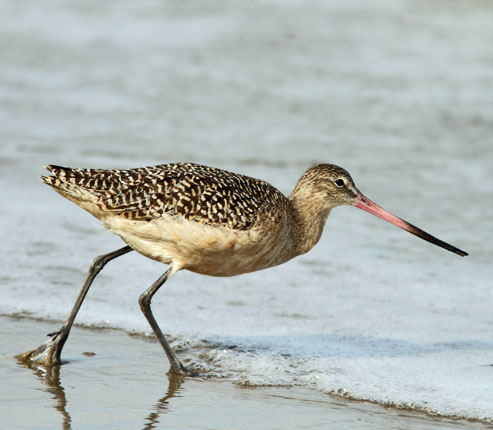
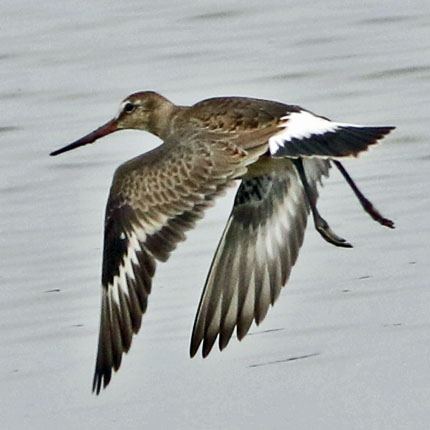









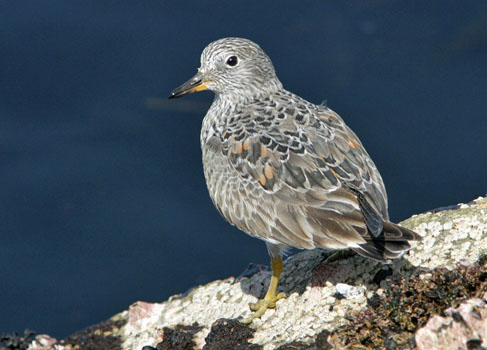

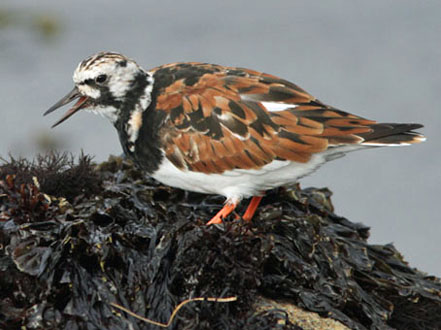
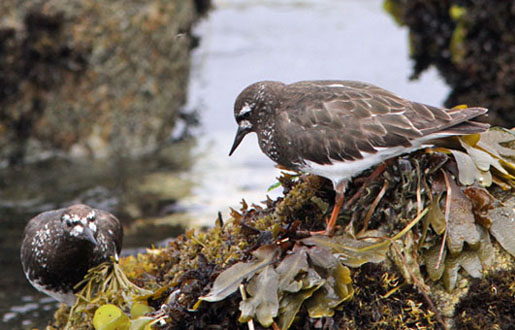
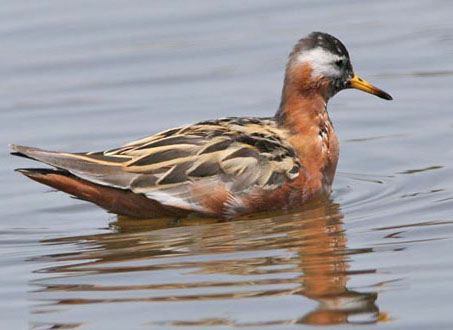

 Sandpipers from four more genera are long-distance migrants. Red Phalarope (above left, breeding-plumaged female) and Red-necked Phalarope (flock with whale shown at top of this page) are Holarctic breeders that migrate widely across the world's oceans to winter in the Southern Hemisphere. In fact, Red Phalarope is entirely pelagic apart from the breeding grounds, coming ashore to coastal ponds only during storms or strong on-shore winds [Red Phalarope is called "Grey Phalarope" in the Old World.] Red-necked Phalarope also migrates inland as well as at sea. Wilson's Phalarope (above right; a flock of juveniles) breeds solely in west-central North America, in prairie pot-holes. Thereafter, nearly all adults undertake a molt migration and stage, often in huge flocks, at saline lakes in the Great Basin, before migrating to similar wintering habitats in the Altiplano of Bolivia and Argentina. All three phalaropes are known for their reversed sex-role mating systems. Larger and more brightly-plumaged females compete for mates and then the males provide all parental care.
Sandpipers from four more genera are long-distance migrants. Red Phalarope (above left, breeding-plumaged female) and Red-necked Phalarope (flock with whale shown at top of this page) are Holarctic breeders that migrate widely across the world's oceans to winter in the Southern Hemisphere. In fact, Red Phalarope is entirely pelagic apart from the breeding grounds, coming ashore to coastal ponds only during storms or strong on-shore winds [Red Phalarope is called "Grey Phalarope" in the Old World.] Red-necked Phalarope also migrates inland as well as at sea. Wilson's Phalarope (above right; a flock of juveniles) breeds solely in west-central North America, in prairie pot-holes. Thereafter, nearly all adults undertake a molt migration and stage, often in huge flocks, at saline lakes in the Great Basin, before migrating to similar wintering habitats in the Altiplano of Bolivia and Argentina. All three phalaropes are known for their reversed sex-role mating systems. Larger and more brightly-plumaged females compete for mates and then the males provide all parental care. 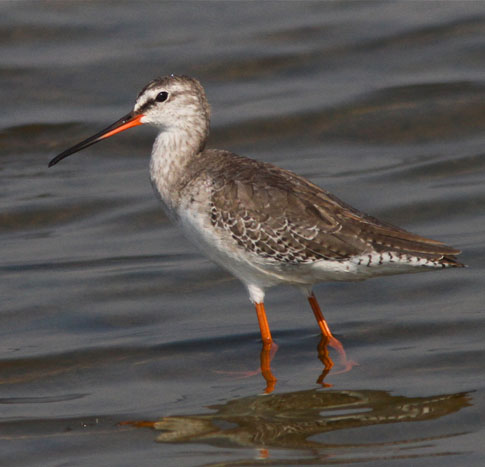

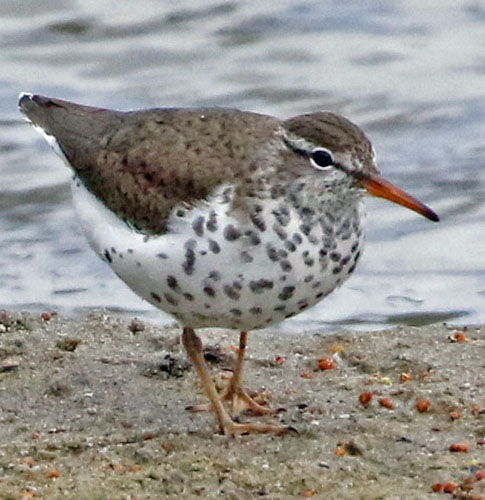
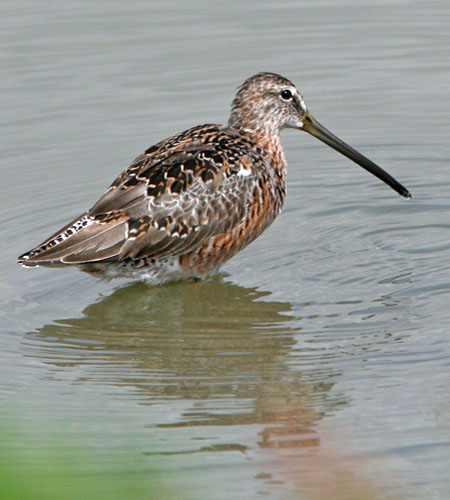
 The final groups of sandpipers are woodcocks (genus Scolopax) and snipes (genus Gallinago). Six of the 8 woodcocks are island endemics in montane cloud forests. The remaining two — Eurasian Woodcock S. rusticola and American Woodcock (right; a collage of two shots of the same bird) — are migratory. These migrants woodcocks nest in extensive woodlands with swamp pools or marshes, and eat primarily earthworms with their long bills in the soft soil. Their breeding system is polyandry, with females choosing mates after observing the males' roding flights. "Roding" is the male display flight, lasting several minutes, typically at dusk and dawn, with slow, deliberate wingbeats, with bill head downwards. Roding may include vocalizations as well. These spectacular "sky-flights" are given by the tropical island species also.
The final groups of sandpipers are woodcocks (genus Scolopax) and snipes (genus Gallinago). Six of the 8 woodcocks are island endemics in montane cloud forests. The remaining two — Eurasian Woodcock S. rusticola and American Woodcock (right; a collage of two shots of the same bird) — are migratory. These migrants woodcocks nest in extensive woodlands with swamp pools or marshes, and eat primarily earthworms with their long bills in the soft soil. Their breeding system is polyandry, with females choosing mates after observing the males' roding flights. "Roding" is the male display flight, lasting several minutes, typically at dusk and dawn, with slow, deliberate wingbeats, with bill head downwards. Roding may include vocalizations as well. These spectacular "sky-flights" are given by the tropical island species also.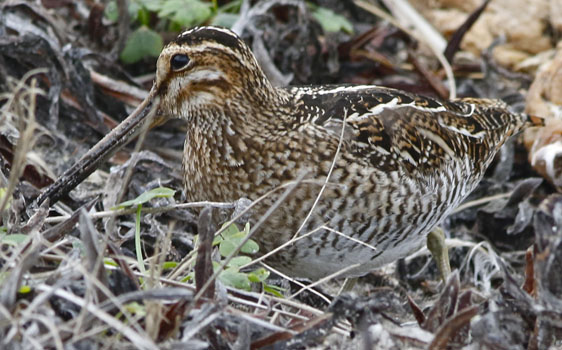
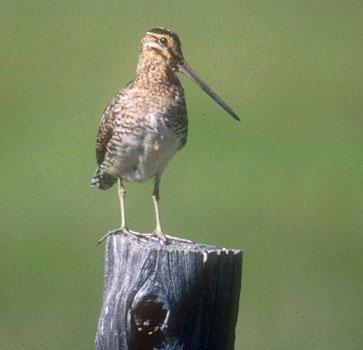
 The Solitary Snipe (left) is a largish snipe of the Himalayas and other mountain ranges in eastern Asia. It is almost exclusively found at high altitudes [1500–5000 m = 5000–16,000 ft elevation], well above treeline, in river valleys, grassy swamps and mountain bogs. This one was foraging alone along a stream at 3200m [10,500' elev] in Bhutan. The population moves downslope when high-elevation waters freeze, but rather little to known about this species.
The Solitary Snipe (left) is a largish snipe of the Himalayas and other mountain ranges in eastern Asia. It is almost exclusively found at high altitudes [1500–5000 m = 5000–16,000 ft elevation], well above treeline, in river valleys, grassy swamps and mountain bogs. This one was foraging alone along a stream at 3200m [10,500' elev] in Bhutan. The population moves downslope when high-elevation waters freeze, but rather little to known about this species.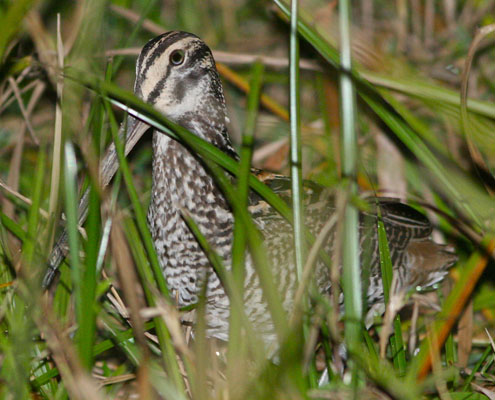
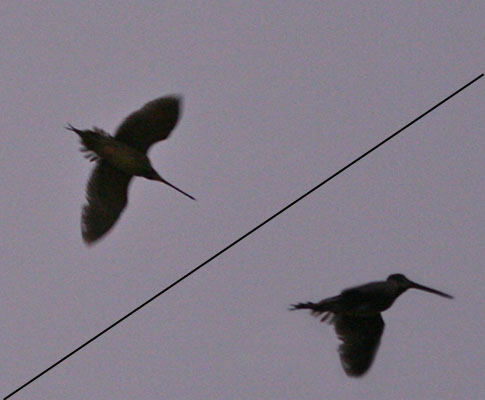
 On another beach, at another time (May 1998), Rita and I had driven hours northward to document another curlew: California's first Bristle-thighed Curlew in Del Norte County (right). It, too, has an amazing story and life history. Although the species was known from oceanic islands, its nesting grounds in western Alaska were not discovered until 1948! (Allen 1948, Allen & Kyllingstad 1949). A recent summary of its biology and behavior reads: "Bristle-thighed Curlew is one of the most unusual of all shorebirds. It is the only migratory shorebird that winters exclusively on oceanic islands and the only shorebird known to become flightless during molt and to use tools when foraging. Like only a handful of other species, it takes on huge fat stores to fuel long nonstop flights over open ocean and reduces the size of its nutritional organs in preparation for these flights. All Bristle-thighed Curlews fly at least 4,000 km (2500 mi) nonstop between Alaska and the northern end of the winter range in the northwestern Hawaiian Islands. Studies of marked birds on Laysan Island revealed that curlews wintering in the Central and South Pacific overfly the Northwestern chain during spring and fall migration, making nonstop flights in excess of 6,000 km (3700 mi) twice each year. Thus, along with Bar-tailed Godwits (Limosa lapponica), Bristle-thighed Curlews make one of the longest nonstop flights known for any bird" (Marks et al. 2020).
On another beach, at another time (May 1998), Rita and I had driven hours northward to document another curlew: California's first Bristle-thighed Curlew in Del Norte County (right). It, too, has an amazing story and life history. Although the species was known from oceanic islands, its nesting grounds in western Alaska were not discovered until 1948! (Allen 1948, Allen & Kyllingstad 1949). A recent summary of its biology and behavior reads: "Bristle-thighed Curlew is one of the most unusual of all shorebirds. It is the only migratory shorebird that winters exclusively on oceanic islands and the only shorebird known to become flightless during molt and to use tools when foraging. Like only a handful of other species, it takes on huge fat stores to fuel long nonstop flights over open ocean and reduces the size of its nutritional organs in preparation for these flights. All Bristle-thighed Curlews fly at least 4,000 km (2500 mi) nonstop between Alaska and the northern end of the winter range in the northwestern Hawaiian Islands. Studies of marked birds on Laysan Island revealed that curlews wintering in the Central and South Pacific overfly the Northwestern chain during spring and fall migration, making nonstop flights in excess of 6,000 km (3700 mi) twice each year. Thus, along with Bar-tailed Godwits (Limosa lapponica), Bristle-thighed Curlews make one of the longest nonstop flights known for any bird" (Marks et al. 2020).